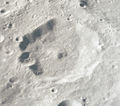Chauvenet (crater)
 Apollo 17 Mapping Camera image | |
| Coordinates | 11°38′S 137°12′E / 11.64°S 137.20°E |
|---|---|
| Diameter | 77.67 km (48.26 mi) |
| Depth | Unknown |
| Colongitude | 224° at sunrise |
| Eponym | William Chauvenet |
Chauvenet is a lunar impact crater that is located to the northeast of the prominent crater Tsiolkovskiy on the far side of the Moon. Less than one crater diameter to the northwest of Chauvenet is the crater Ten Bruggencate.
The rim of this crater is roughly circular, with the satellite crater Chauvenet C overlying the northeastern side and intruding into the interior. A ridge runs from the western side of this intruding feature to the midpoint of the interior of Chauvenet. The remainder of the floor is marked only by a number of tiny craters. There is a shelf of slumped material forming a terrace along the southeast inner wall. The remainder of the inner wall is somewhat irregular in form.
The crater was named after American astronomer and mathematician William Chauvenet by the IAU in 1970.[1] The crater was known as Crater 290 prior to naming.[2]
Satellite craters
[edit]By convention these features are identified on lunar maps by placing the letter on the side of the crater midpoint that is closest to Chauvenet.
| Chauvenet | Latitude | Longitude | Diameter |
|---|---|---|---|
| C | 10.4° S | 138.0° E | 48 km |
| D | 10.6° S | 139.7° E | 14 km |
| E | 11.4° S | 140.7° E | 27 km |
| G | 12.7° S | 141.0° E | 26 km |
| J | 13.9° S | 139.3° E | 77 km |
| L | 13.3° S | 137.5° E | 10 km |
| P | 14.5° S | 135.8° E | 12 km |
| Q | 13.3° S | 135.4° E | 42 km |
| S | 12.3° S | 134.4° E | 38 km |
| U | 11.0° S | 135.2° E | 11 km |
The name Cornielle was proposed for Chauvenet S crater,[3] but it was not approved by the IAU.
-
Oblique view of Chauvenet Q from Apollo 17
References
[edit]- ^ Chauvenet, Gazetteer of Planetary Nomenclature, International Astronomical Union (IAU) Working Group for Planetary System Nomenclature (WGPSN)
- ^ Lunar Farside Chart (LFC-1A)
- ^ LTO-84D4 Volkov — L&PI topographic map
- Andersson, L. E.; Whitaker, E. A. (1982). NASA Catalogue of Lunar Nomenclature. NASA RP-1097.
- Blue, Jennifer (July 25, 2007). "Gazetteer of Planetary Nomenclature". USGS. Retrieved 2007-08-05.
- Bussey, B.; Spudis, P. (2004). The Clementine Atlas of the Moon. New York: Cambridge University Press. ISBN 978-0-521-81528-4.
- Cocks, Elijah E.; Cocks, Josiah C. (1995). Who's Who on the Moon: A Biographical Dictionary of Lunar Nomenclature. Tudor Publishers. ISBN 978-0-936389-27-1.
- McDowell, Jonathan (July 15, 2007). "Lunar Nomenclature". Jonathan's Space Report. Retrieved 2007-10-24.
- Menzel, D. H.; Minnaert, M.; Levin, B.; Dollfus, A.; Bell, B. (1971). "Report on Lunar Nomenclature by the Working Group of Commission 17 of the IAU". Space Science Reviews. 12 (2): 136–186. Bibcode:1971SSRv...12..136M. doi:10.1007/BF00171763. S2CID 122125855.
- Moore, Patrick (2001). On the Moon. Sterling Publishing Co. ISBN 978-0-304-35469-6.
- Price, Fred W. (1988). The Moon Observer's Handbook. Cambridge University Press. ISBN 978-0-521-33500-3.
- Rükl, Antonín (1990). Atlas of the Moon. Kalmbach Books. ISBN 978-0-913135-17-4.
- Webb, Rev. T. W. (1962). Celestial Objects for Common Telescopes (6th revised ed.). Dover. ISBN 978-0-486-20917-3.
- Whitaker, Ewen A. (1999). Mapping and Naming the Moon. Cambridge University Press. ISBN 978-0-521-62248-6.
- Wlasuk, Peter T. (2000). Observing the Moon. Springer. ISBN 978-1-85233-193-1.


